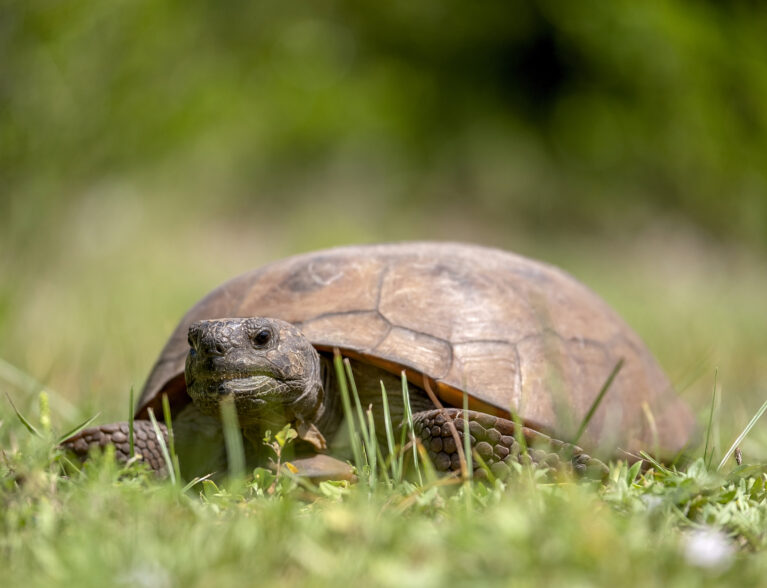
A developer hopes to begin construction soon on an 811-unit residential development just east of Sandridge Golf Club, but first it has to gently evict an estimated 283 gopher tortoises and relocate them to a quieter, safer neighborhood.
The moving cost for the tortoises: It could exceed $2 million!
County staff are poring over initial plans submitted by Pennsylvania developer Toll Brothers for Ridge Top Planned Development on approximately 160 acres at the southwest corner of 77th Street and Old Dixie Highway. Ridge Top is slated for 277 single-family homes, 194 multi-family villas, and 340 multi-family two- and three-story rental apartments, along with a clubhouse, recreation areas and a dog park, according to county documents.
The county’s Sandridge Golf Club is adjacent to the site on the west. The site is within the county’s designated Urban Services Boundary, with county water and sewer available.
Since 2008, Florida has listed the gopher tortoise as threatened and both the tortoise and its burrows are protected by law.
Before developers can begin clearing land, they must obtain permits from the Florida Fish and Wildlife Conservation Commission (FWC) to survey, capture and relocate the tortoises. While this sounds fair enough, doing so is a lengthy and expensive process that can cost up to $8,000 or more per animal.
The cost to relocate the tortoises was $900 per animal when Mark Lafurno first became an FWC-authorized gopher tortoise agent. Since then, “it’s become big business, in a way,” Lafurno said.
“There is a lot of capital involved in setting up an approved recipient site.” And there is a lot of demand for recipient sites as development continues to chug along in Florida, he said.
The relocation process starts by obtaining approval for a permitted recipient site, usually a large tract of private or public land, often a cattle ranch, located in the central part of the state, Lafurno said. Then the animals are trapped and relocated to the recipient site within 72 hours to minimize trauma and stress on the tortoises, he said.
Atlantic Environmental Permitting and Mitigation conducted an initial environmental assessment of the Top Ridge property in March 2022. In addition to analyzing the soil, trees, vegetation and water bodies, Atlantic surveyed 20 percent of the 151 acres of suitable tortoise habitat, as required by FWC.
Atlantic found 113 “potentially occupied” tortoise burrows, leading to the estimate 565 burrows could exist across the entire 151 acres. Tortoises can use up to two or three burrows, so it was estimated 283 tortoises would need to be captured and relocated.
The state application fee alone to mitigate 283 tortoises is approximately $93,000. The cost to trap them and relocate them to an approved recipient site could run $5,500 to $8,000 or more per animal – or a total cost for Ridge Top’s developers between $1.7 million and $2.4 million. A more specific estimate will be derived from a 100% survey immediately before ground is broken, but developers have to pay the estimated application fee up front.
Like it or not, it is a cost of doing business for developers that most people don’t know about, Sorrow said. “This is very typical for a development like this, to find tortoises on site,” Sorrow said. “Our intent is to abide by all the federal and state regulations.
“All of these environmental regulations take a toll on development and are reflected in the costs of the end product,” he said.
Developers can save money by keeping some tortoises onsite, providing there is enough suitable habitat. Sorrow said they are looking at that possibility and have set aside nine acres of upland that would be suitable tortoise habitat. Any final decision would come closer to groundbreaking after a 100% survey is completed, he said.
Sorrow hopes to submit plans for the PD to the county planning a zoning board early in 2025.
The current zoning for the parcels is RM-6, medium density multi-family residential, and IG, general industrial. They will ask the county for a zoning change to PD, Planned Development – which allows for more flexibility in design and a mixture of uses.
Next, they will apply for site development permits, which can take 4-6 months. Then construction of infrastructure such as streets, sewer lines, electric utilities and sidewalks can begin, Sorrow said.
“We think a lot of people are going to love calling this community home,” Sorrow said.
But most of the tortoises who called it home will not be among them.
What to do, and not do, if you encounter a gopher tortoise
The gopher tortoise is one of six North American tortoise species and is the only tortoise naturally found east of the Mississippi River. Gopher tortoises can be found in all 67 Florida counties. More than 350 other species, such as snakes, frogs, small mammals and invertebrates, rely on the gopher tortoise’s burrow for survival.
Gopher tortoises are listed as Threatened in Florida and both the tortoises and their burrows are protected by Chapter 68A-27 of the Florida Administrative Code. The No. 1 threat to gopher tortoises is loss of habitat due to development. They usually meet an untimely end crossing busy streets in search of food or wide-open new spaces.
If you see a tortoise in the road, either leave it alone or you can move it off the road but only in the direction it was traveling. Gopher tortoises have a natural “homing instinct,” Jones said, and if you move them to the opposite side of the road, they will turn back around and head in the original direction, right back into the road.
If you can’t stop, or if the turtle is injured, contact the Alliance on Facebook with the cross streets and a volunteer will be contacted to come help the animal. You also can report injured or deceased tortoises to FWC by calling 850-921-1030 or 561-625-5122.
If you find a tortoise on your property and believe it needs to be relocated for its safety, or you’re worried it might damage your home or yard, contact the Alliance. Do not disturb the burrow or attempt to move the animal yourself. Only a licensed FWC gopher tortoise agent can move them, Jones said.
Tortoises require well-drained loose soil, low-growing herbs for food, and open sunlit areas for nesting. Burrows average 15 feet long and about 6 feet deep and are also home to up to 350 other species. The animals spend about 80 percent of their time in their burrows and forage in the morning and late afternoon.



